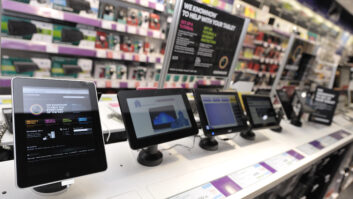NEW YORK – Holiday 2013 will go down in the retail history books as one of extremes: extreme discounts, extreme weather and extremely early.
The combination, said merchants and analysts, resulted in a ho-hum holiday for retailers, and even some consumers whose Christmas deliveries were delayed by a crush of last-minute online orders, or marred by the massive breach of Target’s private-label credit card data.
All told, retail sales of electronics, apparel, jewelry, luxury items and home furnishings rose 3.5 percent year over year for the Nov. 1 to Dec. 24 period, according to Master- Card. “Holiday sales were a clear improvement over last year’s weaker numbers,” said MasterCard Advisors’ market insights senior VP Sarah Quinlan, although “having six fewer shopping days between Thanksgiving and Christmas, as well as bad weather in some parts of the country for the final two weekends of the season, clearly had an effect on sales.”
For brick-and-mortar merchants, the urge to jumpstart the season led to Thanksgiving Day openings, which together with renewed price moves by Walmart, took much of the steam out of December sales. As Conn’s chairman/CEO Theo Wright told analysts at a J.P. Morgan investor conference last month, “Sales over the Thanksgiving weekend were strong in all categories and remained on trend. This year, we opened our Thanksgiving Day for the first time. Without the sales on Thanksgiving Day, we wouldn’t have performed nearly as well for the weekend. Americans have decided they want to shop on Thanksgiving. Because of this, regretfully we have asked our associates to work on Thanksgiving Day.”
Warren Chaiken, president/ COO of national majap and CE distributor Almo Corp., concurred on the scenario. “Thanksgiving changed the Black Friday paradigm,” he said, and taught the industry two things: “One, Black Friday begins as soon as you finish your turkey dinner, and two, those who didn’t participate on Thursday got hurt.”
Retailers and their customers were also faced with a compressed selling season, marked by an early Hanukkah and six fewer shopping days and one less weekend between Thanksgiving and Christmas. But many of their sales and shopping strategies were dashed by a spate of pre-winter storms that put a damper on a critical shopping period across much of the nation. Two weekends out from Christmas, regional dealers “were hurt by the snow and ice,” Chaiken said. “I’m seeing them do unnatural promotional things right now due to the lost days, and that’s a shame.”
Indeed, ShopperTrak reported that foot traffic fell 21.2 percent from Dec. 16 through Dec. 22, the last full week before Christmas, while store visits on so-called “Super Saturday” – the last Saturday before the holiday and traditionally one of the busiest shopping days of the year – fell 18.1 percent and sales slipped 0.7 percent despite additional discounts and procrastinator promotions.
“Bad weather throughout the country kept some shoppers away from stores,” said Bill Martin, founder of the market research firm. “[That] week was their final opportunity to complete their holiday shopping before Christmas – and though many did finish making their purchases, retailers did not see as many shoppers as last year.”
Instead, consumers let their fingers do the last-minute walking, driving double-digit online sales and contributing to the overloaded logistical systems that resulted in the delivery snafus by UPS and FedEx.
But not all of the softness can be blamed on the weather, the calendar, or Walmart’s pledge to “win the holiday” with steep discounting. Bob Lawrence, CEO of the $14 billion BrandSource buying group for independent dealers, said the federal government’s shutdown in October sent a shudder through shoppers which they never fully recovered from.
“Things were going pretty well in October, we were seeing some nice growth numbers, and then everything came to a screeching halt,” he recalled. “I’m not sure the government understood the impact of its actions. Consumers panicked, and customer traffic just stopped.”
By mid-December, dealers were just beginning to regain the momentum they lost, Lawrence said, resulting in a November-December period that was “just okay, not outstanding.”
One positive, he added, was the dearth of extreme discounting. “It was good to see nobody doing anything really insane. A lot of blood had been shed in the past on who can pick up the most market share, but how long can everyone go without making any money?”
Brick-and-mortar retailers managed to recoup some of their lost sales days during the post-Christmas period, particularly the first three days after the holiday when many are still home on vacation, and markdowns, gift card redemptions, and accessory purchases for presents drove robust retail sales and store traffic.
“Many people who have the day after Christmas off of work will be out shopping for end-of-season deals,” said ShopperTrak’s Martin. “Retailers should track their stores’ conversion rates closely to turn more after- Christmas browsers into buyers.”
Best Buy, for one, wasted no time post-Santa with a storewide end-of-the-season sale starting Dec. 26 that featured extended store hours, open-box and clearance specials, and a $15 gift card or credit with purchases of $100 or more.
To help independents bring customers back post-holiday, distributor Petra Industries mailed a 32-page “Everything Santa Forgot” flier to more than 40,000 dealers, e-tailers and custom install integrators nationwide. The catalog is filled with accessories like sound bars and cases for the iPhone 5s and 5c that complement CE holiday gifts and give retailers the opportunity to increase sales and expand their margins.
“As accessory specialists we know that many times the gifts found under the tree are missing the accessories necessary to fully enjoy their features and functions,” Petra president Tate Morgan said. – Additional reporting by Steve Smith








